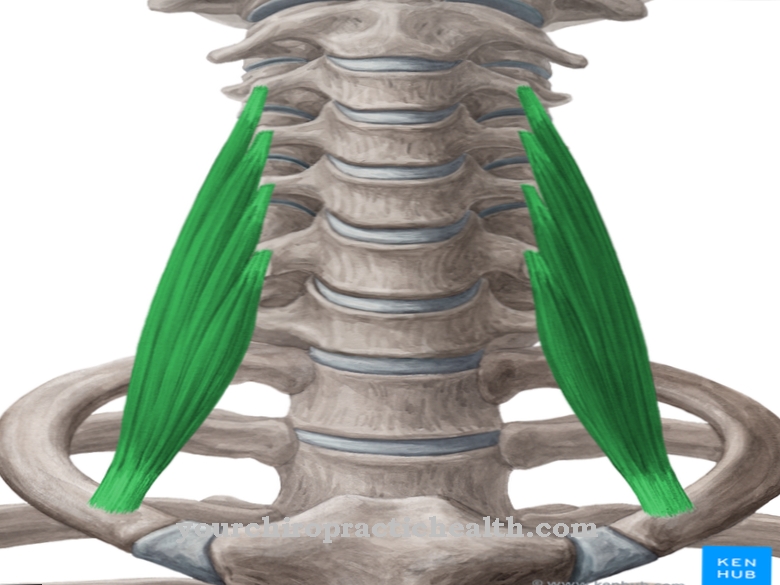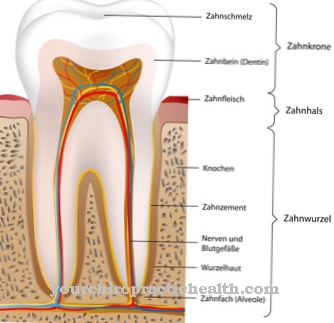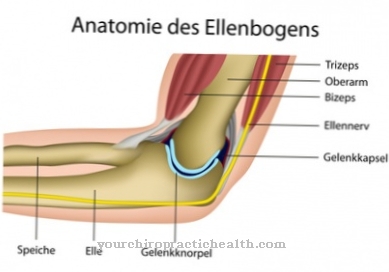Of the biceps denotes the Biceps brachii muscle. It is found in humans in the upper arm, but can also be found in quadruped mammals (such as dogs). In both cases he is responsible, among other things, for bending the arm or the front leg.
What characterizes the biceps brachii muscle?
The upper arm muscle, often called the "two-headed muscle of the arm" or briefly as biceps is a skeletal muscle made up of two heads of muscles. It is located on the upper or front of the upper arm and is responsible for bending the arm. For this reason it is also called "arm flexor". The two-headed hamstring muscles are also known as biceps. However, the term for the upper arm muscle is more common than for Biceps femoris muscle.Anatomy & structure
Medicine understands the two-headed muscle of the arm to be a skeletal muscle located in the upper arm. Of the Biceps brachii muscle consists of two muscle heads: the Caput longum (also long head) and that Caput breve (also known as a short head). These two heads are responsible for the naming of the muscle. In humans, they arise from the shoulder blade. The two heads of the biceps connect roughly where they are also visible from the outside. Here they become a single muscle body or muscle belly. This muscle belly sits below the elbow, labeled directly on the muscle hump Radial tuberosity the radius (medically called the radius), together with a tendon of the upper arm. This tendon goes into the Aponeurosis musculi bicipitis (also sinewy muscle origin) and into the fascia of the forearm (the Antebrachial fascia) over. In contrast to humans, the biceps in quadruped mammals such as dogs, cats and horses has only one origin at the small bony hump (Supraglenoid tubercle) of the shoulder blade. As a result, the biceps only has one head in this case. From a comparative anatomical point of view, however, it is still referred to as two-headed in medicine and thus also as biceps.
Function & tasks
The biceps is responsible for twisting the forearm out of its home position so that the thumb rotates inside out and around the hand - until it is pointing vertically up and in the opposite direction from the home position. The anatomy speaks of this function as supinating. If the forearm is already in a supinated position, the biceps is able to bring it back to its original position. Another task of the biceps is to bend the forearm in the elbow area.
Both heads have their own tasks that individually affect the entire function of the biceps. The long head is used when the upper arm is to be lifted off or away from the chest. The short head is responsible for movements in which the arm should be brought towards the chest.
In addition, both muscle heads act simultaneously on the sequence of movements when the arm is to be moved away from the body and forwards. The two heads are also necessary for the internal rotation of the arm. Here they work together to create a smooth movement. In addition, they work together to ensure that the arm is not turned too far. This will prevent injuries.
A difference in function can be found in the biceps again in the comparison between humans and animals - in quadruped mammals the biceps acts as a connection between the leg and the shoulder joint and acts exclusively as a flexor of the elbow. Rotational movements are not common in animals such as dogs, cats and horses and are therefore not intended. For this reason, their biceps are less strong and stronger. It is also slightly weaker than the biceps in humans or other two-legged mammals.
You can find your medication here
➔ Medicines for painIllnesses & ailments
The most common ailment associated with the biceps in humans is biceps tendon rupture. With this rupture, the tendon or the tendon of origin of the muscle tend to tear. Another and similar injury can be a muscle strain. In most cases, both injuries result from trauma, as can an accident.
A rupture or strain of the biceps can also result from a short or long-term overload of the upper arm. In older people, a rupture or strain of the muscle often occurs as a result of age-related wear and tear. The muscle often gets weaker with age and thus more prone to injury.
A disorder of the biceps, on the other hand, is a pulley lesion. Medicine speaks of this when there is an unnatural displacement of the tendon of origin. Such a lesion usually occurs when the tendon shifts obliquely in the groove of the shoulder joint over time. This can happen, among other things, through overloading, but also through an accident.
In rare cases, the tendon is offset accordingly at birth. A shift in the tendon over time causes it to thin out, making it more prone to injury. Often times, the pulley lesion ends with the biceps tendon tearing. For this reason, medicine generally speaks of such when there is a displacement-related injury to the tendon.
























.jpg)



